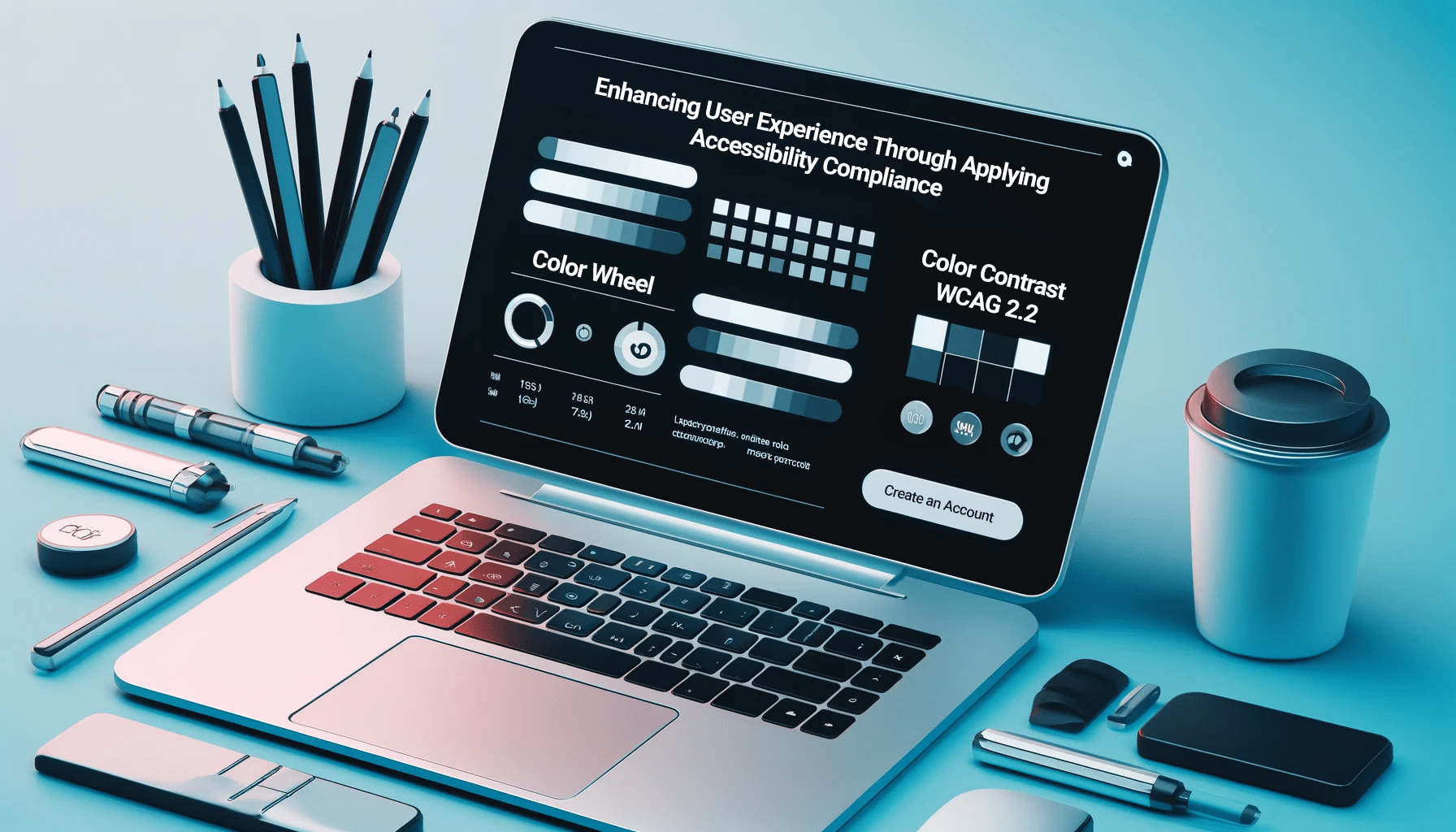Introduction
Have you ever considered how some websites are much more accessible and user-friendly than others?
It’s because they know the Web Content Accessibility Guidelines (WCAG).
The Web Content Accessibility Guidelines were developed by the World Wide Web Consortium (W3C) and have been around since 1999. The W3C launched multiple versions of WCAG over time to ensure the guidelines evolved with the accessibility needs of society.. At the moment, the latest version is WCAG 2.1 with version 2.2 pending approval.
Before we dive into why the WCAG matters, you need to understand what it is—it’s more than just guidelines.
What is WCAG?
WCAG is a framework that acts as the beacon to guide developers when creating web content and interfaces that are inclusive to everyone.
When the first version of WCAG was launched back in 1999, the primary goal was to ensure content and software developers had accessibility guidelines to follow to ensure their website was accessible to all users, regardless of disability or how they access the content.
In fact, version 1.0 of WCAG had a checklist of 14 guidelines developers used to ensure users could consume content and interact with a website using a keyword, or screen readers and other assistive technologies. These 14 guidelines included:
- Offer alternatives for both auditory and visual content.
- Avoid relying solely on color.
- Implement markup and style sheets correctly.
- Clarify the use of natural language.
- Design tables to adapt gracefully.
- Ensure smooth adaptation of pages using new technologies.
- Allow users to control time-sensitive content changes.
- Guarantee direct accessibility of embedded user interfaces.
- Create designs suitable for various devices.
- Employ temporary solutions when necessary.
- Follow W3C technologies and guidelines.
- Provide context and orientation information.
- Include precise navigation mechanisms.
- Ensure documents are straightforward and clear.
How have the Web Content Accessibility Guidelines changed over the years?
The W3C have made substantial enhancements to WCAG with each version update, reflecting the evolving landscape of digital accessibility.
With each iteration, the guidelines become more comprehensive, fine-tuned, and responsive to technological advancements.
WCAG 1.0
If you think about what the internet was like back 20+ years ago, it was much simpler than what it is today.
Loading speeds were slower, electronic mail addresses (yes, that’s what email was called) were primarily used for personal conversations between friends, and finding information online was much simpler, given the competition for Google rankings wasn’t as challenging as it is today.
When the first version of WCAG was launched, it focused on ensuring people using the web could read what was on the screen.
When the World Wide Web evolved from Web 1.0 (1989-2005) to Web 2.0 (2000-2010), there was a shift in what it was actually used for. The shift from the “read-only” era to the era of social networking required changes to the Web Content Accessibility Guidelines. Not only did users need to be able to read what was on the screen, they now also needed to be able to interact with it.
WCAG 2.0
Not long after Web 2.0, the W3C launched its next version: WCAG 2.0.
At this time, the web now became a place to create social connections. Myspace, Facebook, Twitter, and later down the line, Instagram, all became places for people to connect online and maintain relationships from afar.
Web Content Accessibility Guidelines 2.0 was a newly updated guideline to keep up with technological advances. So, instead of the list of 14 guidelines we mentioned earlier, the WCAG developed four principles that made the guildeines easier to adapt to evolving technologies. The principles are:
1. Perceivable
Information and user interface elements should be displayed in formats that users can easily understand.
2. Operable
User interface elements and navigation should be functional and easy to use.
3. Understandable
Information and the functioning of the user interface should be easy to understand by users.
4. Robust
Content should be strong enough to be reliably understood by different user agents, including tools that assist people with disabilities.
Of course, each principle has a set of guidelines to follow. However, the goal of the principles is to be helpful and followed, even as technology advances.
WCAG 2.1
Let’s fast forward to 2018, the era of Web 3.0:
- Amazon’s net sales reached $232.9 billion.
- Netflix was streaming in 130 countries.
- Apple launched iPhones with facial recognition and an improved dual-lens camera.
- Everything became a touch screen.
- What was once an information source became a virtual world.
As technology continues to advance and impact everyone’s daily lives, we need to ensure our methods and standards of providing equal access to digital assets keep up.
This is why the W3C launched WCAG 2.1.
There are minor differences between WCAG 2.0 vs. 2.1. For instance:
1. Mobile Accessibility
WCAG 2.1 places more emphasis on ensuring accessibility for mobile devices. As smartphones and tablets have become more common, the new guidelines clearly advise making websites work well on these devices, especially when using touchscreens.
2. Cognitive and Learning Disabilities
WCAG 2.1 brings in rules that help people with cognitive and learning challenges. This involves making content easier to grasp, move around, and work with, allowing a broader range of people to engage with it.
3. Low Vision Accessibility
The new guidelines are enhanced for low-vision users by offering improved contrast ratios, text spacing, and adaptability options.
4. Keyboard Navigation
WCAG 2.1 provides more comprehensive recommendations for keyboard navigation, ensuring that all users, including those who rely on keyboard input due to motor disabilities, can effectively interact with web content.
5. Timing and Animation
The new guidelines tackle problems with timing and animations, giving options and controls for users who might find flashing content difficult or need more time to read and understand things.
6. Sensory Disabilities
WCAG 2.1 introduces guidelines to help people with sensory disabilities. This ensures that those who rely on hearing or touch cues can see and understand the content.
7. Language and Content Clarity
The updated version emphasizes clear and straightforward language usage, benefiting users with difficulties comprehending complex vocabulary or sentence structures.
Now, artificial intelligence increasingly impacts technological advancements and innovations, leading to a need for newer methods and standards for accessibility. To address these needs, the W3C plans to launch its latest version of the guidelines, WCAG 2.2, by the end of August 2023.
Why is WCAG 2.1 important for digital accessibility compliance
As the latest active version, WCAG 2.1 includes the necessary standards, guidelines, and criteria crucial to ensuring disabled users have equal access to digital content.
Nowadays, we do everything online. We turn to travel influencers for travel tips instead of hiring a travel agency; we order Uber and Lyft instead of taxis; we set up autopay for bills and subscriptions instead of calling a care representative or mailing a check.
As we shift to the convenience of the web, WCAG 2.1 provides the necessary requirements for companies and organizations to follow so everyone can keep up with the new ways of living. This guarantees equal opportunities for everyone and serves as a foundation for officials and lawmakers to improve their accessibility efforts.
There are several accessibility acts passed by governments across Canada. The Accessibility for Ontarians with Disabilities Act (AODA) is a great example. Ontario’s bill was passed in 2005 and aims to make Ontario fully accessible by 2025. The bill requires all public and private sectors to create policies, practices, and accessibility plans that identify, remove, and prevent accessibility barriers.
The public and private sectors can refer to WCAG 2.1 for the latest accessibility update to ensure they maintain AODA compliance as society’s technological advancements continue to evolve.
How does WCAG 2.1 impact and benefit society?
Because the W3C created new versions of WCAG criteria and standards, public and private organizations can update their practices and policies to address issues disabled people commonly experience.
Organizations that implement accessibility standards and guidelines into their policies and practices foster a sense of belonging to society. Enabling those with a disability to better engage online with society benefits them and everyone around them.
Online interactions become easier and everyone progresses effortlessly. For instance, downloading and reviewing bank statements on pdf files becomes seamless and ordering takeout on SkipTheDishes becomes quick and satisfying.
Implementing policies that allow those with a disability to better engage online and with society benefits them and everyone around them. Society becomes fluid, and everyone progresses effortlessly.
Applying WCAG 2.1 and its updates will benefit you and those around you
The digital revolution is only as revolutionary as it is inclusive. As we create, share, and explore content across the web, WCAG 2.1 acts as the bridge that spans accessibility gaps to remove barriers. It represents a commitment to building a digital world where everyone can navigate, participate, and thrive.
With WCAG’s new 2.2 version on the horizon, let’s recognize that each line of website code adhering to these guidelines is a step towards a more inclusive future.
What has your organization done to implement new policies and standards toward accessibility?
If you’re stuck on the answer, let Accessibility Partners help identify existing barriers and show you how to improve your accessibility status. Fill out the contact form below, and we’ll provide a free consultation.







